Chelicerate Characteristics
- Body divided into prosoma (fused head and thorax) and opisthosoma (abdomen)
- First pair of appendages modified for feeding: chelicerae
- Appendages biramous
- Lack antennae
|
Class Merostomata — Horseshoe Crabs

Atlantic Horseshoe Crabs, Limulus polyphemus; mating aggregation; DE
|
Characteristics
- Prosoma covered by large, U-shaped carapace
- 5 Pairs of walking legs
- Abdominal appendages flattened into "book gills"
- Long posterior tail (= telson)
- 5 Living species, on ocean bottoms
- Also includes the now-extinct Eurypterids (giant sea scorpions)
|
|
Class Arachnida
Characteristics
- Additional feeding appendages: pedipalps & maxilla
- 4 pairs of walking legs
- Lack abdominal appendages (except for spinnerets in some)
- Nearly all are terrestrial
- Respiration via book lungs or trachea
|
|
Order Acari
- Ticks and mites
- Most very tiny (< 1 mm)
- Very diverse
- Some are external parasites
|
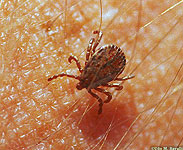
Hard Tick, Dermacentor sp.; CA
|
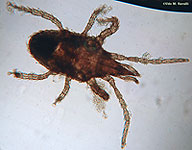
Predatory Mite, AZ
|
|
Order Araneae
- Spiders
- 36,000 Species
- Most are predators
- Chelicerae modified into venom fangs
- Silk glands and spinnerets
|
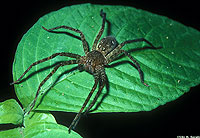
Nursery Web Spider (Pisauridae); Ecuador
|
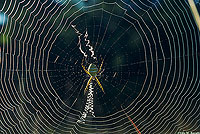
Banded Agriope, Argiope trifasciata; Kenya
|
|
Order Opiliones
- Harvestmen & Daddy-Long-Legs
- Small bodies but very long legs
- Predators or scavengers
- 1 Pair of eyes
- Reduced chelicerae
|

Brown Daddy-long-legs, Phalangium opilio; KY
|
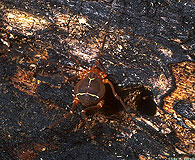
Ornate Harvestman, Vonones ornata; KY
|
|
Order Scorpiones
- Scorpions
- Abdomen divided into Mesosoma and "tail"
- Large pedipalps form pincers (chelae)
- Venomous stinger at end of tail
- Reduced chelicerae
|
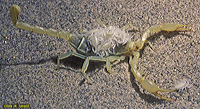
Coachella Valley Sand Scorpion, Paruroctonus mesaensis; female carrying young.
|

Uroctonus Scorpion, Uroctonus mordax; CA
|
|
Other Orders
- Know as Arachnids, but do not need to know Order
- Tailless Whipscorpions
|
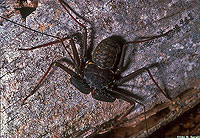
Tailless Whipscorpion, Tarantula sp.; Order Amblypygi; FL
|
|
Class Pycnogonida — Sea Spiders
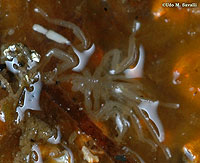
Unidentified Sea Spider; LaJolla, CA
|
Characteristics
- Small bodies with proportionately long legs (>3x body length)
- Body not differentiated into regions
- Unique proboscis
- Usually 4 pairs of walking legs
- Marine predators on slow-moving or sessile prey
- Larvae are parasitic (mostly on Cnidarians)
|
|










